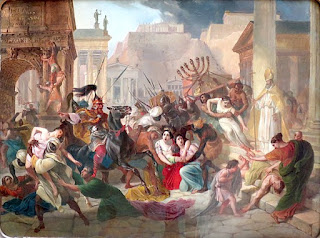This was obviously a challenge to Rome's power, but Rome was busy on another front: Attila the Hun and his brother Blaeda had been a problem for years. Worse, a request from Emperor Valentinian III's sister to Attila for help complicated matters: Attila thought Honoria was offering herself in marriage, and Attila wanted half the Roman Empire as dowry. Being informed by Valentinian that he had clearly misunderstood the situation, Attila attacked Gaul in 453. This was drawing Rome's military forces substantially inland and away from the Mediterranean coasts.
Rome had a stroke of luck in that Attila died not long after the invasion of Gaul. His three sons' eagerness each to rule a part of the Hun empire helped reduce its effectiveness. Rome could now turn its attention to Genseric and the Vandals—for all the good that did.
Valentinian decided on a diplomatic route, offering his daughter in marriage to Genseric's son. This might have satisfied both sides, but for something neither side saw coming: Valentinian was murdered on 16 March 455 by the senator Petronius Maximus. Maximus bribed the Senate to support him; he married Valentinian's widow, married Valentinian's daughter to Maximus' own son.
Maximus got to be emperor for two and a half months. Genseric, understandably enraged at this betrayal, headed to Rome. Valentinian's widow supposedly sent a message to Genseric or his son requesting saving from Maximus. Maximus requested help from the Visigoths, but it was not forthcoming. He fled Rome as the Vandals arrived, became separated from his retinue in the chaos of escaping, and was killed. The Vandals went on to sack Rome (illustrated above in a 19th-century painting).
The only contemporary account of the sacking of Rome comes from Prosper of Aquitaine (also one of the rare early sources of info on St. Patrick). Prosper says that Pope Leo I ("the Great") asked Genseric to satisfy himself with pillaging, but refrain from murder and destruction. The Vandals not only left Rome with many treasures, but also with Valentinian's widow and daughter.
It would seem that nothing prevented the Vandals from ruling that part of the world indefinitely. Their fortunes were about to turn, however, and we'll see how that happened next time.

